
Amy Martin offers tips for creating a mini-prairie wildscape in your backyard. Above, the Native Texas Park at the George Bush Presidential Center in Dallas. Photo by Scooter Smith.
April 3, 2018
 Pocket prairies, small handcrafted parcels redolent with native grasses and wildflowers, are beautiful and easy to maintain. The intricate landscape changes week by week, reflecting the seasons. They bring a bit of the wild to your life while providing food and habitat for songbirds and pollinators. The prairies upon which the avian and insect world depend are disappearing every day to development. With only 2 percent or less of prairies remaining, pocket prairies are increasingly crucial to reversing the dramatic plunge in biodiversity.
Pocket prairies, small handcrafted parcels redolent with native grasses and wildflowers, are beautiful and easy to maintain. The intricate landscape changes week by week, reflecting the seasons. They bring a bit of the wild to your life while providing food and habitat for songbirds and pollinators. The prairies upon which the avian and insect world depend are disappearing every day to development. With only 2 percent or less of prairies remaining, pocket prairies are increasingly crucial to reversing the dramatic plunge in biodiversity.
“This miniature wildscape mimics the closely planted native grasses and self-sowing wildflowers that work together in a harmonious mix in a typical prairie. From a distance, prairies might look to you like a vast sea of grass, but a closer look shows intermingled perennials that come and go with the seasons, supporting a huge number of insect and bird species,” says Carolyn Hestand Kennedy, North Haven Gardens marketing and advertising manager.
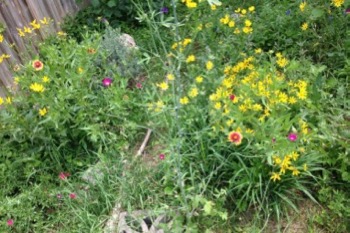
A functioning prairie of any size depends on perennials and is active through the fall. It needs not just flowers but ones that make edible seeds for birds, not just nectar flowers for butterflies but the plants their caterpillars require. Some plants' flowers turn into seed cases that bugs colonize, attracting insect-eating birds. Just tossing out a typical wildflower seed mix — full of non-natives, mostly spring annuals and no native grasses — won’t do.
A backyard pocket prairie in Fort Worth. Photo by Julie Thibodeaux.
Creating the fabulous, complicated living web of life of a prairie can be a challenge.
“This is not a type of landscape that can be installed over a weekend,” says Kennedy, “but once established, it can sustain itself with very little water and minimal maintenance.”
Visit a Local Pocket Prairie
Inspire yourself to create a pocket prairie by visiting one in North Texas. Native Texas Park at George W. Bush Presidential Center is the biggest at 15 acres. Michael Van Valkenburgh Associates designed the ecosystem with input from Lady Bird Johnson Wildflower Center and several local native-plant landscaping experts. Opened in 2013 along with the library, Native Texas Park is a living tribute to the love Bush and his wife had for rural Prairie Chapel Ranch where they restored the prairie. This little-known natural treasure is open seven days a week from dawn to dusk.
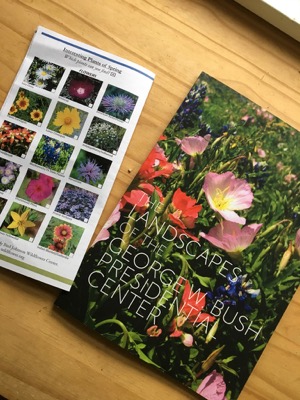 Volunteer docent Lois Diggs led GreenSourceDFW on a walk of the park’s one mile of paved and soft-surface trails punctuated by benches and impressive black-locust bridges. The recreated Blackland Prairie flanks a waterway and pond. A curved slope leads from gentle hills down to a pondside amphitheater. In the process, multiple microhabitats emerge. Tallgrasses such as Indian, switch and big bluestem dominate the moister hilltop soil, while the slope favors wildflowers that prefer it dry and well drained. Around the pond is a wetlands prairie. The heavily treed riparian corridor is reminiscent of Cross Timbers. All these ecosystems can be evoked in most yards.
Volunteer docent Lois Diggs led GreenSourceDFW on a walk of the park’s one mile of paved and soft-surface trails punctuated by benches and impressive black-locust bridges. The recreated Blackland Prairie flanks a waterway and pond. A curved slope leads from gentle hills down to a pondside amphitheater. In the process, multiple microhabitats emerge. Tallgrasses such as Indian, switch and big bluestem dominate the moister hilltop soil, while the slope favors wildflowers that prefer it dry and well drained. Around the pond is a wetlands prairie. The heavily treed riparian corridor is reminiscent of Cross Timbers. All these ecosystems can be evoked in most yards.
A book about the Native Texas Park sold at the Bush Presidential Center gift shop features a detailed site map and plant lists. Photo by Julie Thibodeaux. Below, The Native Texas Park at George W. Bush Presidential Center is landscaped with a variety of grasses, trees and wildflowers common to North Texas. Photo by Scooter Smith.
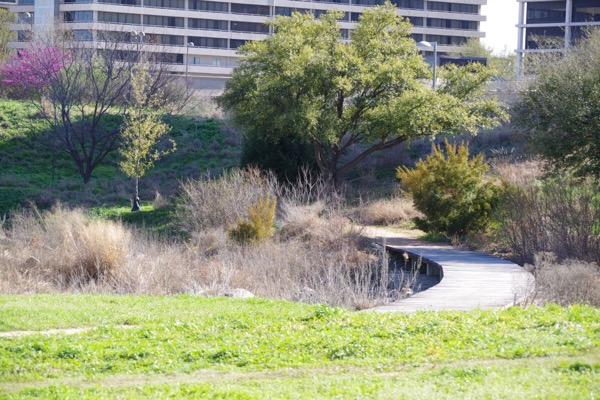 As we stand on the sheltered edge of the riparian, looking up at the great slope where bluebonnets are about to pop, Diggs relates:
As we stand on the sheltered edge of the riparian, looking up at the great slope where bluebonnets are about to pop, Diggs relates:
“To stand a moment and listen to the birds in the trees, to see the grasses move and all the color, even with the cars on the expressway nearby the beauty here is so full. When I lead tours, this is the spot where I remind people, ‘This park is a gift from Mr. and Mrs. Bush so you can enjoy it and see how their Prairie Chapel Ranch restored them.’ I hope that maybe they consider doing something a little something like this at home.“
Diggs leads tours of the park every Saturday into June.
Downloads at the Native Texas Park website are useful in familiarizing yourself with the park’s plants beforehand. Being on North Central Expressway, it’s easy to tell where north is, making it a prime place to study which plants prefer east and west facing exposure. Especially examine how the park’s designers manage water flow by slowing it down with limestone and forming places where it can gather for future release.
Other pocket prairies and prairie/pollinator gardens:
• Alliance Town Center in north Fort Worth evokes Native Texas Park with its focus along a refashioned waterway and pond. A .5-mile trail with wildlife-friendly native plants and naturalist signage winds through Bluestem Park, a restored Blackland Prairie parcel.
• Pollinator Pocket Prairie is near the Cicada Pavilion of Lewisville Lake Environmental Learning Area. It is wildly full of bees, butterflies and other pollinating insects that the website states “are in steep decline across the United States due to loss of habitat, overuse of insecticides and other environmental issues. Without these hard‐working and often unappreciated creatures, about 75 percent of our flowering plants and crops would not develop fruit or seeds.”
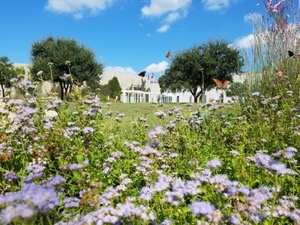 • Botanical Research Institute of Texas adjacent to the Fort Worth Botanic Garden is replete with native plant and prairie gardens. Open on first Saturdays.
• Botanical Research Institute of Texas adjacent to the Fort Worth Botanic Garden is replete with native plant and prairie gardens. Open on first Saturdays.
• Heard Museum & Wildlife Sanctuary is developing a prairie and pollinator garden for teaching McKinney-area schoolchildren.
• Molly Hollar Wildscape, located in Veteran’s Park in Arlington, is a half-acre intricate and inviting native plant wildscape run by volunteers.
• Frankford Prairie Chapel, though is it a genuine remnant Blackland Prairie rather than a created pocket prairie, is petite at 2.5 acres. The grounds of a lovingly restored historic prairie church and cemetery boast over 200 species of plants — an astounding diversity.
The Botanical Research Institute of Texas features a restored prairie on its campus. Courtesy of BRIT.
Pocket Prairie Basics
Gardeners have created pocket prairies as small as a sandbox in yards, sandwiched between more formal beds, or tucked in as a backdrop behind a fountain pond. More often they stretch along odd strips between a fence and driveway or along an alley fence. Or fill in unused expanses like the backs or sides of yards.
A few tips:
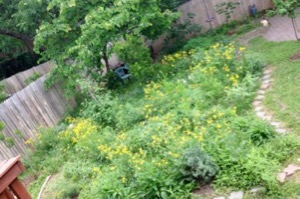 • Find a sunny location. Most grasses and wildflowers need at least a few hours of sunlight, but many need a full day. Morning sun can be less harsh on flowers than afternoon sun. Try to find a situation where you have full sun as well as partial shade for the widest array.
• Find a sunny location. Most grasses and wildflowers need at least a few hours of sunlight, but many need a full day. Morning sun can be less harsh on flowers than afternoon sun. Try to find a situation where you have full sun as well as partial shade for the widest array.
• Choose a well-drained spot. For most grass and wildflower species, standing water is hard to survive, especially if it goes on for days. Then again, a few species love wet feet. Controlling your water flow so there are both well drained and continually most areas is vital.
• Select along a back or side fence line rather than close to the street. A pocket prairie adjacent to where birds and animals travel or shelter works best. Linked together they serve as urban wildlife corridors.
• Try to include a water feature. Nothing attracts wildlife as much as water. A recirculating fountain if possible, even just a small one, or at least a basin or birdbath.
• Tall in the back. When it comes to pocket prairie design, Kennedy relates it to the “Thriller, Filler & Spiller” technique for planting containers. Tall showy plants serve as a backdrop, a mix of medium to tall plants make up the middle part and draping plants form the edges.
“Use groups of tall plants, bushy ones, as well as groundcover types to form a close-knit community that works together to protect bare soil and provide seasonal interest. Allow wildflowers to go to seed and add additional seed each year as needed to fill in gaps.”
• Pocket prairies need not be limited to homes. Medians, right of ways, greenbelts and school and business spaces can be refashioned with permission to create pocket prairies. Schools such as Rosemont Middle School next to Twelve Hills Nature Center use that preserve’s pocket prairie as an outdoor learning classroom.
Above, pocket prairie in Fort Worth. Photo by Julie Thibodeaux.
Native Plant Classes
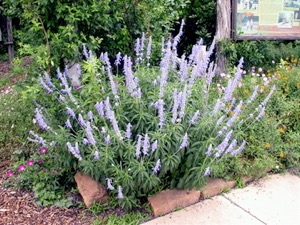 It helps to have mentors when learning to create a native plant ecosystem in your yard. The Native Plant Society of Texas is here to help. Check out their chapters: Collin, Dallas, Denton and Fort Worth. Their newsletters and monthly meetings provide a wealth of information.
It helps to have mentors when learning to create a native plant ecosystem in your yard. The Native Plant Society of Texas is here to help. Check out their chapters: Collin, Dallas, Denton and Fort Worth. Their newsletters and monthly meetings provide a wealth of information.
Blue salvia at the Molly Hollar Wildscape in Arlington. Courtesy of Molly Hollar Wildscape.
The Dallas NPSOT chapter offers a Native Landscape Certification Program. Students learn about 50 native plants and other aspects of landscaping with natives. It includes a walk to see selected plants growing in their natural setting.
Level 1 is an introduction to native landscapes, with plant identification and native garden ecology. Level 2 covers how to design and implement a landscape, and Level 3 is installation and maintenance of native landscapes.
While the Dallas classes in April at the George W. Bush Presidential Library and its Native Texas Park are full, and Denton and McKinney classes have begun, sign up to be notified of the next round.
Look for pocket prairie and lawn conversion classes at North Haven Gardens, Botanical Research Institute of Texas, and nature centers with prairies such as Heard Museum & Wildlife Sanctuary and Bob Jones Nature Center.
Native Plant Resources
 Plant Guides: The go-to online resource for native plants info is the Lady Bird Johnson Wildflower Center. Texas Flora is a Facebook group that assists with native plant identification. The website of Native American Seed features concise information on plants.
Plant Guides: The go-to online resource for native plants info is the Lady Bird Johnson Wildflower Center. Texas Flora is a Facebook group that assists with native plant identification. The website of Native American Seed features concise information on plants.
Native American Seed in Junction offers a variety of seeds for Texas prairie flowers and grasses. Courtesy of NAS.
Plant Sales: To connect you to native plants, GreenSourceDFW compiled this list of North Texas native plant sales. Texas Discovery Gardens puts on a huge one, and NPSOT chapters sponsor many.
Seeds: In addition to Native American Seed, these sell both native grasses and flower seeds: Bamert Seed, Turner Seed and Wildseed Farms.
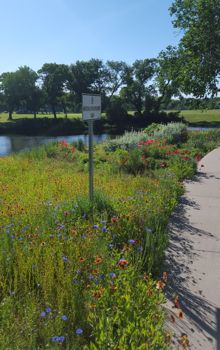 Books: These books can be very helpful:
Books: These books can be very helpful:
• Bringing Nature Home: How You Can Sustain Wildlife with Native Plants by Douglas W. Tallamy
• How to Grow Native Plants of Texas and the Southwest by Jill Nokes and Kathryn Miller Brown
• Landscaping with Native Plants of Texas by George Oxford Miller
• Native Texas Plants: Landscaping Region by Region by Sally Wasowski and Andy Wasowski
Pocket wildflower garden at Lake Cliff Park in Dallas. Photo by Monica Johnson.
Article:
How to Design Native Landscapes by Carol Feldman
Landscaping: If you’d rather hire someone to craft a pocket prairie for you, North Haven Gardens, Redenta’s Garden, Rohde's Organic Landscape Services and Weston Gardens are among those that can. Native plant landscape design firms include Feldman Design Studios (Dallas) and Happy Gardens (Fort Worth).
RELATED ARTICLE
North Texas native plant sales spread grassroots gardening trend
Stay up to date on everything green in North Texas, including the latest news and events! Sign up for the weekly Green Source DFW Newsletter! Follow us on Facebook and Twitter.









